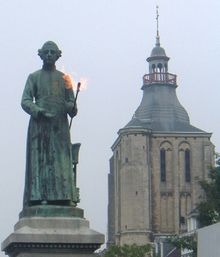Jean-Pierre Minckelers


Jean-Pierre Minckelers (first name also Jan Pieter, last name also Minkelers or Minckeleers) (b. Maastricht, Netherlands, 1748; d. there 4 July 1824) was an inventor of illuminating gas.
At the age of sixteen, in 1764, he went to the University of Leuven (French: Louvain), where he studied theology and philosophy at the Collegium Falconis, in which he became professor of natural philosophy in 1772.
At this time the question of aerostats and Montgolfier balloons was occupying the mind of scientists, and Louis Engelbert, 6th Duke of Arenberg, a promoter of science and art, engaged a committee to examine into the question of the best gas for balloon purposes. Minckelers was on this committee, and in 1784, after many experiments, published a work entitled Mémoire sur l'air inflammable tiré de différentes substances, rédigé par M. Minkelers, professeur de philosophie au collège du Faucon, université de Louvain (Louvain, 1784). As an appendix to this memoir there was a Table de gravités spécifiques des différentes espèces d'air, by T.F. Thysbaert, a member of the committee.
In his memoir Minckelers tells us how he made his discovery: from the very beginning of his experiments he had had the idea of enclosing oil in the barrel of a gun and heating it in a forge. Under action of the heat the oil dissolved and gave way to a very light gas, having other advantageous qualities. Having proved that oil gas was the best for balloons, Minckelers used it for many balloons which rose rapidly and travelled great distances in the neighbourhood of Leuven. As we learn from his pupil von Hulstein, who was in his class in 1785, Minckelers at times used this same gas to light his workshop. Moreover, the drift of his memoir proves clearly that in its inventor's eyes the great combustibility of the gas was one of its leading qualities. When Joseph II, in 1788, transferred the Catholic University of Leuven to Brussels, Minckelers continued as professor, but when it was removed back to Leuven he refused to return. He resigned in 1794 and was appointed professor of physics and chemistry at the Central School of Maastricht.
In 1816 he became member of the Royal Institute of the Netherlands.[1]
References
- ^ "Jan Pieter Minckelers (1748 - 1824)". Royal Netherlands Academy of Arts and Sciences. Retrieved 26 July 2015.
- Attribution
 This article incorporates text from a publication now in the public domain: Herbermann, Charles, ed. (1913). "Jean-Pierre Minkelers". Catholic Encyclopedia. New York: Robert Appleton Company. Cites:
This article incorporates text from a publication now in the public domain: Herbermann, Charles, ed. (1913). "Jean-Pierre Minkelers". Catholic Encyclopedia. New York: Robert Appleton Company. Cites:
- MINKELERS, Mémoire sur l'air inflammable tiré de différentes substances (Louvain, 1784);
- DE RAS, Historisch Verslag over J. P. Minkelers (Maastricht, 1897);
- VERHAEGEN, Les cinquante dernières années de l'université de Louvain (Liège, 1894);
- DE BOCKE, De vervaardiging van lichtgas uit steenkolen (Alkmaar, 1882).
Bibliography
- P.A.Th.M. Jaspers, De ontwikkeling van de pharmacie in Limburg gedurende de Franse Tijd, Venlo: Dagblad voor Noord Limburg 1966, pp. 126, passim;
- P.A.Th.M. Jaspers, J.P. Minckelers 1748-1824, Maastricht: Stichting Historische Reeks 1983;
- H. Nabben, Lichter dan lucht, los van de aarde, Barneveld: BDU Uitgevers 2013.
External links
- Gas in the 1911 Encyclopædia Britannica
- H. A. M. Snelders (1988). "The New Chemistry in the Netherlands". Osiris. 4, The Chemical Revolution: Essays in Reinterpretation (2): 121–145. doi:10.1086/368675. JSTOR 301746.
